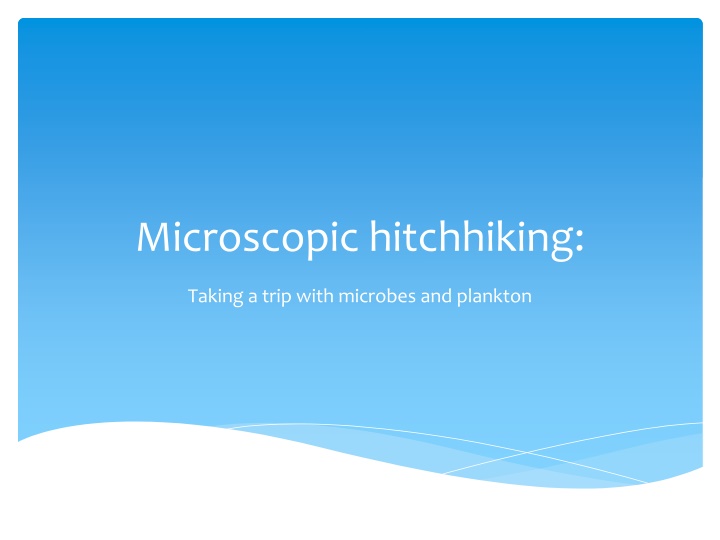
Exploring Microscopic Hitchhiking: The World of Microbes and Plankton
Dive into the fascinating realm of microbes and plankton on a microscopic hitchhiking adventure. Discover the diverse organisms, from bacteria to jellyfish, that play essential roles in our ecosystems. Learn about the importance of plankton in food webs, the threats of eutrophication, and how these tiny beings impact disease dynamics in aquatic environments.
Download Presentation

Please find below an Image/Link to download the presentation.
The content on the website is provided AS IS for your information and personal use only. It may not be sold, licensed, or shared on other websites without obtaining consent from the author. If you encounter any issues during the download, it is possible that the publisher has removed the file from their server.
You are allowed to download the files provided on this website for personal or commercial use, subject to the condition that they are used lawfully. All files are the property of their respective owners.
The content on the website is provided AS IS for your information and personal use only. It may not be sold, licensed, or shared on other websites without obtaining consent from the author.
E N D
Presentation Transcript
Microscopic hitchhiking: Taking a trip with microbes and plankton
Microbes? Plankton? Yes, microbes are small. But they are definitely not all the same. Microbe is a term that refers to microscopic organisms, such as bacteria, protozoa, fungi, algae, and even really small animals! Not all microbes are pathogenic, and without them, we probably wouldn t be able to breathe or eat.
Yummy! Plankton: drifter, wanderer (from Greek planktos) Well, plankton is also not one organism, but a group of organisms that live in the water and can t swim against currents. Although they are small, plankton organisms provide a crucial source of food to many large organisms, including commercially important fish and even whales! Jaontiveros, Wiki Commons, 2010.
Plankton Some plankton species are microbes! Plankton species include microbes as bacteria, microalgae, protists; and animals that can be really small as copepods (tiny crustaceans) and as big as jellyfish. This is a real copepod. Uwe Kils, Wiki Commons, 2005.
Lets talk about their home: the water. Since plankton is so important in food webs (can anyone give examples?), it is directed affected by pollution. Here in Chesapeake Bay, it faces a major threat called eutrophication.
Eutro-what? Eutrophication is the water body s response to the addition of artificial or natural nutrients, a form of water pollution. Untreated sewage, manure, paper pulp, and agricultural run-offs are sources of excess organic matter that may result in eutrophication. Eutrophication results in uncontrolled growth of bacterial populations because of the nutrient loading, which may end up depleting dissolved oxygen in the water, killing many aquatic animals.
Eutrophication and Diseases Eutrophication can impact disease and parasite dynamics, since it affects species abundances and distribution. Organisms are more stressed, making them more susceptible to disease and parasites. Collectively, these pathogens may be dangerous because they can continue to cause mortality even as their hosts decline, potentially leading to sustained disease or extinctions. Adam Lindquist, Creative Commons, 2011. Eutrophication can lead to harmful algal blooms, as some of you may have seem in the Bay.
Quick review Now that we reviewed some important aspects about microbes, plankton, and eutrophication, let s get a little more into a special relationship. Proyecto Agua, Creative Commons, 2009. Leo Papandreou, Creative Commons, 2009. This is a ciliate, a unicellular microbe. This is a copepod, a small crustacean, and the most common planktonic animal.
Epibiosis Epibiosis is what we call when an organism attaches to the outside of another living being. Epibiotic traditionally commensals, particular Chesapeake Bay plankton might change that idea! organisms viewed but species are as one in
Who is that little guy? Zoothamnium intermedium is a ciliate protist that lives on copepod hosts. This is a picture of them fresh from the lab!
So, its a plankton and microbe interaction? Although it doesn t damage any copepod tissue, these hitchhikers can cause a variety of detrimental effects such as interference with feeding, locomotion, reproduction, growth, ability to survive, and even increased sensitivity to contaminants. Wow! This ciliate is not a parasite but it sure behaves like one! x x L.Safi, adapted from http://www.clker.com/clipart-plankton.html
Its all about the food You may be wondering what does this ciliate epibiont eat, since they only take a ride on top of the copepod. This ciliate feeds on bacteria from the water, and that is what we are going to research today. But let s think about the whole picture for a moment. Copepods can be found in Chesapeake Bay, right? The Bay has been experiencing eutrophication, growth, remember? resulting in bacterial
So More bacteria in the water means what for the ciliate? What do you think this epibiont has in common with parasites? Do you think the epibiont-copepod relationship may be influenced by eutrophication? Let s get started with the next activity!
